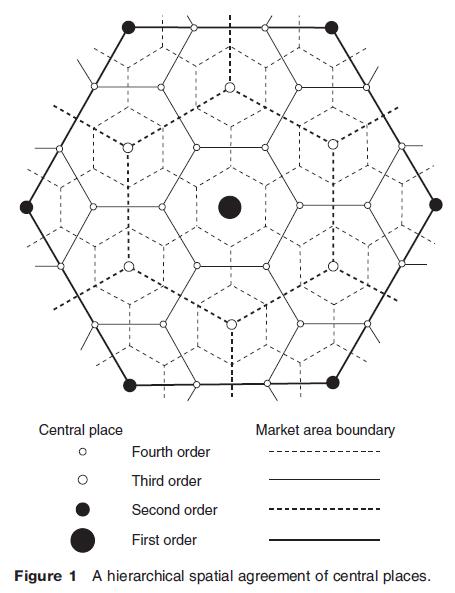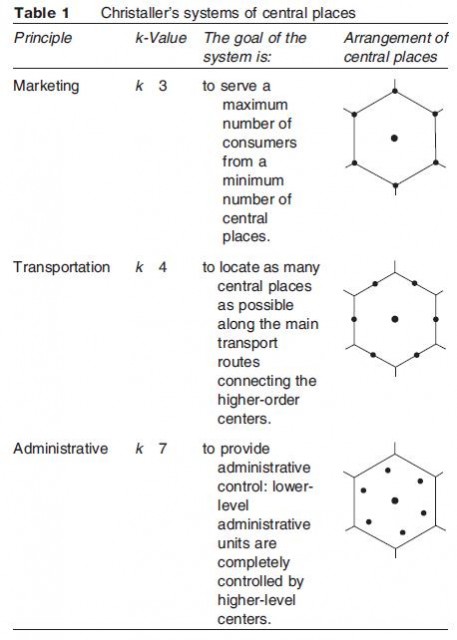Classical Central Place Theory
A Single-Function Central Place System
The central place model is based on a series of simplifying assumptions. It assumes that economic activities are taking place on an isotropic surface – an idealized region which is completely flat and homogeneous in every respect. This implies that there are no barriers to movement and the transportation cost per unit of distance is the same in all directions. The theory also presupposes that population and income are evenly distributed over the region. Finally, it is assumed that both consumers and producers have perfect knowledge and act entirely rationally with respect to this knowledge.
Given these simplifying assumptions, central place theory introduces two economic parameters which control the potential locations of individual central places: the threshold (the minimum level of demand necessary to support business activity) and the range of a good (the maximum distance a consumer is willing to travel to purchase a good or service). The theory addresses the spatial interplay between the threshold and range. Using these two parameters the central place model demonstrates how an economic landscape evolves towards a spatial equilibrium in which a single function central place system consists of equal, regular hexagonal market areas, just large enough to contain the threshold demand, served by central places located at equal distance from each another.
Multiple-Function Hierarchical Systems
The hexagonal pattern of market areas generated by the single function model provides a starting point for a more complex multiple function hierarchical system of central places. A key concept underlying the multiple function framework is that of the order of a place which is derived from the orders of goods (and services) that are available in it. Some goods have a low threshold and a correspondingly low range (low order goods), whereas others need a much higher level of demand for their existence and are characterized by a more extensive range (high order goods). Since threshold demand and market range vary enormously for different goods and services it is impossible for all the central place functions to be carried on in all central places. Lowest order goods and services are available at a large number of locations, highest order goods at only a small number of locations. Accordingly, Christaller's urban system is arranged in a nested hierarchy of central places and market areas with lower order market areas completely contained within higher order areas (Figure 1). Central places on each level of the hierarchy are characterized by a specific mixture of functions in accordance with their threshold and range values. At the top of the hierarchy is the highest order center with many specialized functions (including other functions as well), at the bottom of the hierarchy there are a great many small central places with a few lower order functions serving small market areas. Each level supplies all the goods and services that the centers below it will provide plus some additional ones. This implies interdependency between levels of the hierarchy in that all centers except the smallest have other centers dependent on them for supply of certain goods and services.

Christaller suggested that the relationships between subsequent levels in the central place hierarchy are fixed and defined by a k value, which indicates the number of lower order centers (hexagonal market areas) served by a central place at the next highest order in the system. Using the k value, Christaller proposed three types of systems based on the marketing, transportation, and administrative principles (see Table 1). According to the marketing principle (or the k=3 network) the hierarchy and nesting pattern results in a system that serves a maximum number of evenly distributed consumers from a minimum number of central places. However, a transportation system to serve such an arrangement is not efficient because the important links between larger central places do not pass through intermediate ones. Consequently, a k 4 network organized according to the traffic principle was proposed to account for situations in which the costs of transportation were significant. The transportation principle results in an arrangement that maximizes the number of central places located on the main transport routes. In the hierarchical arrangement according to the marketing and transportation principles, lower order places (or market areas) located between higher order centers are divided equally among three centers in the case of the marketing principle, and between two centers in the case of transportation principle. Such a division of smaller areas and larger ones is inefficient from the perspective of spatial arrangement for purposes of administration. Consequently, Christaller suggested that in regions with a highly developed system of central administration a k=7 hierarchy would tend to develop. In this arrangement, the hexagonal market areas of the smaller settlements are completely enclosed within the market area of the larger settlement. Efficient administration is the control principle in this hierarchy.

Losch's Variable-k Hierarchies
Christaller's models are based on the assumption that the k values, once adopted, would be fixed; that is, they applied equally to the relationships between villages and towns, towns and cities, cities and metropolitan places, and so on, through all the tiers of the central place hierarchy. Losch used a similar hexagonal unit for his central place model but he improved and extended Christaller's form. The major difference between the two approaches was that Losch regarded the fixed k assumption as a special limiting case. Losch developed variable k hierarchies by allowing various hexagonal systems to coexist. This was achieved by superimposing the hexagonal network for one level of central places upon the network for another and then rotating the networks until the maximum degree of spatial association of central places was obtained. The reason for doing this was to minimize the route distances necessary to link the settlement pattern; as a result, it increased the efficiency of the spatial organization. In this manner, Losch generated a pattern of sectors radiating from the largest urban center (the highest order central place) in a given region. The Loschian landscape is composed of city rich sectors alternating with sectors containing few urban places. This tendency of the urban system to form a sort of radial banding around the highest order central place is in reality reinforced by transportation patterns.
While in Christaller's model hexagonal market areas are arranged in a nested pattern with the market areas of lower order goods packed within those of higher order goods, in Losch's model there is a much more complex web of interconnected market areas. Specifically, the Loschian spatial organization is characterized by a less distinct hierarchical structure than that proposed by Christaller because (1) central places of the same size do not necessarily perform the same range of functions, (2) higher order central places need not have all of the functions of lower order centers, and (3) the citysize distribution is more likely to follow the ranksize rule.